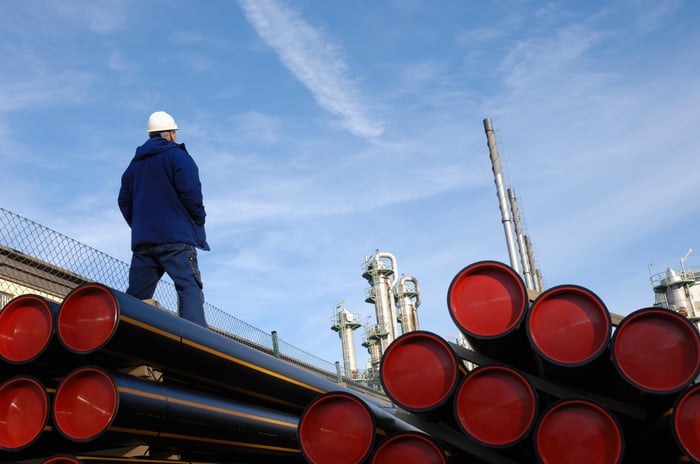Kinder Morgan (KMI -0.32%) has been under a cloud of uncertainty over the past several years, and investors weren't quite sure what the future held for the natural gas pipeline giant.
But in the last year, the company has gone to great lengths to improve its outlook, and we now have a pretty good idea where Kinder Morgan will be one year from now.

Image source: Getty Images.
Where Kinder Morgan stands today
At this time last year, there was still plenty of uncertainty about Kinder Morgan's future. While the company said that it would finally start returning more cash to shareholders, since it was on pace to achieve its debt reduction target, its growth prospects remained unclear. On the one hand, a pipeline the company had in development (the Gulf Coast Express) took a giant leap forward after a new partner joined its team. On the other, there were increasing concerns that it wouldn't be able to expand the Trans Mountain Pipeline in Canada.
That uncertainty has faded over the past several months. For starters, Kinder Morgan sold Trans Mountain to the Canadian government, which not only clarified that situation but provided the company with a pile of cash to pay down debt. Because of that, the company lowered its leverage target from 5 times debt-to-EBITDA to 4.5, which puts its balance sheet on an even stronger footing.
And the company not only moved forward with the Gulf Coast Express natural gas pipeline, but also quickly signed up enough shippers to give the Permian Highway Pipeline the green light. Because of that, investors have a good idea of what to expect from the pipeline giant in the next year.

Image source: Getty Images.
Turning to the future
Kinder Morgan has already given investors a good hint of what to expect in 2019. They can bank on the company fulfilling its promise to increase its dividend by 25% in 2019. With its balance sheet the strongest it has been in years, and one large growth project rolling off by midyear, the company has the financial flexibility to meet this commitment. Because of that, investors who buy today can effectively lock in a 5.5% yield.
Investors can also expect some closure on its publicly traded Canadian subsidiary Kinder Morgan Canada (KML). The company is exploring its options for that entity following the sale of Trans Mountain, since Kinder Morgan Canada's original purpose was to be a vehicle to finance that expansion project. While the company could continue to operate and grow that entity, it has hired advisers to explore a sale of its remaining assets. Because of that, it's likely that Kinder Morgan will either sell Kinder Morgan Canada to another midstream company focused on that country or take it private. A sale would provide it with more cash to further strengthen its balance sheet, buy back shares, or invest to expand its U.S. footprint; privatization would reduce its complexity.
Meanwhile, investors should expect even more clarity on the company's long-term growth prospects over the course of the next year. Kinder Morgan currently has a backlog of about $7 billion of expansion projects. That's down from $12.2 billion at this time last year, due to the removal of Trans Mountain as well as the recent completion of several other projects.
The company has a few more expansions underway that it should finish by this time next year, including the Elba liquefaction terminal -- which will make liquified natural gas (LNG) -- and some gas pipeline projects around the country.
While those project completions will drain the backlog, the company has the financial flexibility to add more projects. It should have no shortage of opportunities since North America needs to invest $44 billion per year in building new energy infrastructure over the next 18 years, with natural gas infrastructure representing more than half of those investments.
Because of those factors, Kinder Morgan feels confident that it can capture $2 billion to $3 billion in projects each year for the foreseeable future. At the low end of its forecast, the company could grow its earnings at a 4% annual rate, and that's assuming a much lower investment return than the average project in its current backlog. Meanwhile, a higher investment rate that earns better returns could drive double-digit annual earnings growth.
More income and clarity await
Kinder Morgan has accomplished a lot over the past year, including giving its investors a 60% dividend increase while solidifying its balance sheet and growth prospects. The company is on track to deliver more of the same in the next year, likely boosting its dividend another 25%, selling or privatizing Kinder Morgan Canada, and locking up more growth projects.
Those factors could give the company's stock the fuel it needs to finally bridge the wide gap between its valuation and its peer group average, which could enable it to deliver a market-smashing return in the coming year.





